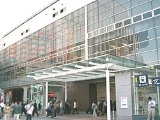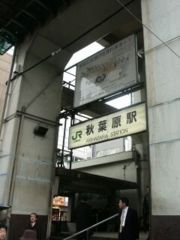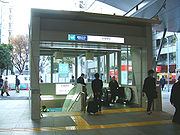
Akihabara Station
Encyclopedia
is a railway station located
in Tokyo
's Chiyoda
ward. It is at the center of the famous Akihabara
shopping district specializing in electronic goods.
 JR East
JR East
:
 Tokyo Metro
Tokyo Metro
:
Metropolitan Intercity Railway Company
:
The above-ground section of the station is cross-shaped, with the Chūō-Sōbu Line tracks running from east to west, and the Yamanote and Keihin-Tōhoku Line (and Tōhoku Shinkansen
, which does not stop at Akihabara) from north to south.
s serving four tracks for the Yamanote Line and the Keihin-Tohoku Line on the 2nd level, and two side platform
s serving two tracks for the Sobu Line Local service on the 4th level.
s serving two tracks.
serving two tracks.
!colspan=5|JR East
|-
!colspan=5|Tokyo Metro
|-
!colspan=5|Metropolitan Intercity Railway Company
station via tracks following the course of the modern day Yamanote Line.
It was opened to passenger traffic in 1925 following the construction of the section of track linking Ueno with Shinbashi via Tokyo Station
and the completion of the Yamanote Line. The upper level platforms were added in 1932 with the opening of an extension to the Sōbu Line from its old terminal at Ryōgoku
to Ochanomizu
, making Akihabara an important transfer station for passengers from the east of Tokyo and Chiba Prefecture
.
The huge growth in commuter traffic following the Second World War caused considerable congestion and was only relieved with the construction of the Sōbu line tunnel linking Kinshichō
with Tokyo, bypassing Akihabara.
The Hibiya Line subway station was opened on May 31, 1962 with
the line's extension from Naka-Okachimachi
to Ningyōchō
.
On August 24, 2005, the underground terminus of the new Tsukuba Express Line opened at Akihabara. The entire station complex, including the JR station, was also refurbished and enlarged in preparation for the opening of the Tsukuba Express.
electronics retail district to the north and west of the station.
in Tokyo
Tokyo
, ; officially , is one of the 47 prefectures of Japan. Tokyo is the capital of Japan, the center of the Greater Tokyo Area, and the largest metropolitan area of Japan. It is the seat of the Japanese government and the Imperial Palace, and the home of the Japanese Imperial Family...
's Chiyoda
Chiyoda, Tokyo
is one of the 23 special wards in central Tokyo, Japan. In English, it is called Chiyoda ward. As of October 2007, the ward has an estimated population of 45,543 and a population density of 3,912 people per km², making it by far the least populated of the special wards...
ward. It is at the center of the famous Akihabara
Akihabara
, also known as , is an area of Tokyo, Japan. It is located less than five minutes by rail from Tokyo Station. Its name is frequently shortened to in Japan...
shopping district specializing in electronic goods.
Lines

East Japan Railway Company
is the largest passenger railway company in the world and one of the seven Japan Railways Group companies. The company name is officially abbreviated as JR East in English, and as in Japanese. The company's headquarters are in Yoyogi, Shibuya, Tokyo....
:
- Keihin-Tōhoku LineKeihin-Tohoku LineThe , is a railway line in Japan which connects the cities of Saitama, Kawaguchi, Tokyo, Kawasaki, and Yokohama. It is part of the East Japan Railway Company network. The line's name is derived from the characters for , and the...
- Yamanote LineYamanote LineThe is commuter rail loop line in Tokyo, Japan, operated by East Japan Railway Company . It is one of Tokyo's busiest and most important lines, connecting most of Tokyo's major stations and urban centres, including the Yūrakuchō/Ginza area, Shibuya, Shinjuku, and Ikebukuro, with all but two of its...
- Chūō-Sōbu LineChuo-Sobu LineThe is a railway line located in Tokyo and Chiba Prefecture, Japan. Part of the East Japan Railway Company network, it runs on separate tracks along the right-of-way of the Chūō Main Line and Sōbu Main Line , providing service between Mitaka Station in the cities of Mitaka and Musashino and...

Tokyo Metro
is one of two rapid transit systems making up the Tokyo subway system, the other being Toei. It is the most used subway system in the world in terms of annual passenger rides.-Organization:...
:
- Tokyo Metro Hibiya LineTokyo Metro Hibiya LineThe is a metro line owned and operated by Tokyo Metro located in Tokyo, Japan. The line was named after the district of Hibiya, under which it passes.-Overview:The Hibiya Line runs between in Meguro and in Adachi...
Metropolitan Intercity Railway Company
Metropolitan Intercity Railway Company
The is a third sector railway company. It was established in March, 1991, to construct the Tsukuba Express . Municipalities along the planned line, and private corporations, invested in it.-External links:...
:
The above-ground section of the station is cross-shaped, with the Chūō-Sōbu Line tracks running from east to west, and the Yamanote and Keihin-Tōhoku Line (and Tōhoku Shinkansen
Tohoku Shinkansen
The is a Japanese high-speed Shinkansen rail line, connecting Tokyo with Aomori in Aomori Prefecture for a total length of 674 km, Japan's longest Shinkansen line. It runs through the more sparsely populated Tōhoku region of Japan's main island Honshu. It has two spur lines, Yamagata...
, which does not stop at Akihabara) from north to south.
JR East
There are two island platformIsland platform
An island platform is a station layout arrangement where a single platform is positioned between two tracks within a railway station, tram stop or transitway interchange...
s serving four tracks for the Yamanote Line and the Keihin-Tohoku Line on the 2nd level, and two side platform
Side platform
A Side platform is a platform positioned to the side of a pair of tracks at a railway station, a tram stop or a transitway. A pair of side platforms are often provided on a dual track line with a single side platform being sufficient for a single track line...
s serving two tracks for the Sobu Line Local service on the 4th level.
Tokyo Metro
There are two underground side platformSide platform
A Side platform is a platform positioned to the side of a pair of tracks at a railway station, a tram stop or a transitway. A pair of side platforms are often provided on a dual track line with a single side platform being sufficient for a single track line...
s serving two tracks.
Tsukuba Express
There is an underground island platformIsland platform
An island platform is a station layout arrangement where a single platform is positioned between two tracks within a railway station, tram stop or transitway interchange...
serving two tracks.
Adjacent stations
|-!colspan=5|JR East
|-
!colspan=5|Tokyo Metro
|-
!colspan=5|Metropolitan Intercity Railway Company
History
Akihabara Station was opened in November 1890 as a freight terminal linked to Ueno StationUeno Station
is a major railway station inTokyo's Taitō ward. It is the station used to reach the Ueno district and Ueno Park -- which contains Tokyo National Museum, The National Museum of Western Art, Ueno Zoo, Tokyo National University of Fine Arts and Music and other famous cultural facilities...
station via tracks following the course of the modern day Yamanote Line.
It was opened to passenger traffic in 1925 following the construction of the section of track linking Ueno with Shinbashi via Tokyo Station
Tokyo Station
is a train station located in the Marunouchi business district of Chiyoda, Tokyo, Japan, near the Imperial Palace grounds and the Ginza commercial district....
and the completion of the Yamanote Line. The upper level platforms were added in 1932 with the opening of an extension to the Sōbu Line from its old terminal at Ryōgoku
Ryogoku Station
is a railway station in Yokoami, Sumida, Tokyo, Japan, operated by East Japan Railway Company and Tokyo Metropolitan Bureau of Transportation .-Lines:...
to Ochanomizu
Ochanomizu Station
is a railway station in Chiyoda, Tokyo, Japan, operated by East Japan Railway Company and Tokyo Metro.-Location:JR East's Ochanomizu station lies next to the Kanda River. During the Edo period, the Kanda River was rerouted to pass through Ochanomizu, which was otherwise a highland between two...
, making Akihabara an important transfer station for passengers from the east of Tokyo and Chiba Prefecture
Chiba Prefecture
is a prefecture of Japan located in the Kantō region and the Greater Tokyo Area. Its capital is Chiba City.- History :Chiba Prefecture was established on June 15, 1873 with the merger of Kisarazu Prefecture and Inba Prefecture...
.
The huge growth in commuter traffic following the Second World War caused considerable congestion and was only relieved with the construction of the Sōbu line tunnel linking Kinshichō
Kinshicho Station
is a railway station in Sumida, Tokyo, Japan, operated by East Japan Railway Company and Tokyo Metro.-Lines:Kinshichō Station is served by the JR East Sōbu Line and Chūō-Sōbu Line, as well as the Tokyo Metro Hanzōmon Line ....
with Tokyo, bypassing Akihabara.
The Hibiya Line subway station was opened on May 31, 1962 with
the line's extension from Naka-Okachimachi
Naka-Okachimachi Station
is a train station in Taitō, Tokyo, Japan.- Adjacent stations :...
to Ningyōchō
Ningyocho Station
is a subway station on the Tokyo Metro Hibiya Line and the Toei Asakusa Line . It is located in the Ningyōchō neighborhood of Nihonbashi, Chūō, Tokyo, Japan. Its numbers are H-13 and A-14 .- Layout :On the Hibiya Line, Ningyōchō has two platforms separated by two tracks...
.
On August 24, 2005, the underground terminus of the new Tsukuba Express Line opened at Akihabara. The entire station complex, including the JR station, was also refurbished and enlarged in preparation for the opening of the Tsukuba Express.
Surrounding area
The main attraction is the AkihabaraAkihabara
, also known as , is an area of Tokyo, Japan. It is located less than five minutes by rail from Tokyo Station. Its name is frequently shortened to in Japan...
electronics retail district to the north and west of the station.

